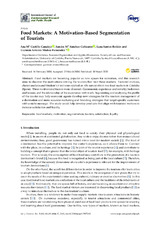Mostrar el registro sencillo del ítem
Food Markets: A Motivation-Based Segmentation of Tourists
| dc.contributor.author | Castillo-Canalejo, Ana Mª | |
| dc.contributor.author | Sánchez Cañizares, Sandra María | |
| dc.contributor.author | Santos Roldán, Luna | |
| dc.contributor.author | Muñoz Fernández, Guzmán Antonio | |
| dc.date.accessioned | 2020-03-30T11:47:30Z | |
| dc.date.available | 2020-03-30T11:47:30Z | |
| dc.date.issued | 2020 | |
| dc.identifier.uri | http://hdl.handle.net/10396/19839 | |
| dc.description.abstract | Food markets are becoming popular as new spaces for recreation, and this research aims to discover the motivations driving the tourists that visit these markets. Factorial analysis, cluster analysis and Student’s t-test were applied on 456 surveys from two food markets in Córdoba (Spain). Three motivational factors were obtained: Gastronomic experience and novelty; hedonism and leisure; and the relationship of the experience with work. Segmenting and analyzing the profile of the tourist may help economic agents develop new strategies for the tourism management of a destination and more accurate marketing and branding strategies that target specific customers with a niche message. The study could help develop products that align with tourists’ motives to increase satisfaction and loyalty. | es_ES |
| dc.format.mimetype | application/pdf | es_ES |
| dc.language.iso | eng | es_ES |
| dc.publisher | MDPI | es_ES |
| dc.rights | https://creativecommons.org/licenses/by/4.0/ | es_ES |
| dc.source | International Journal of Environmental Research and Public Health 17(7), 2312 (2020) | es_ES |
| dc.subject | Food markets | es_ES |
| dc.subject | Motivation | es_ES |
| dc.subject | Segmentation | es_ES |
| dc.subject | Tourists | es_ES |
| dc.subject | Satisfaction | es_ES |
| dc.subject | Loyalty | es_ES |
| dc.title | Food Markets: A Motivation-Based Segmentation of Tourists | es_ES |
| dc.type | info:eu-repo/semantics/article | es_ES |
| dc.relation.publisherversion | http://dx.doi.org/10.3390/ijerph17072312 | es_ES |
| dc.rights.accessRights | info:eu-repo/semantics/openAccess | es_ES |

